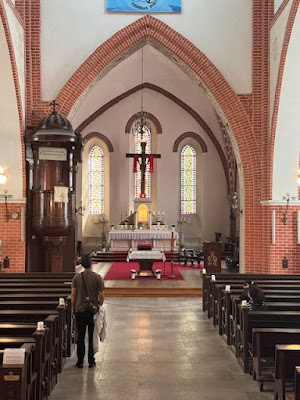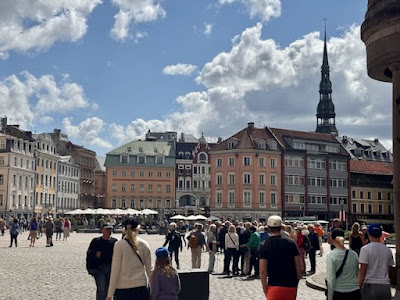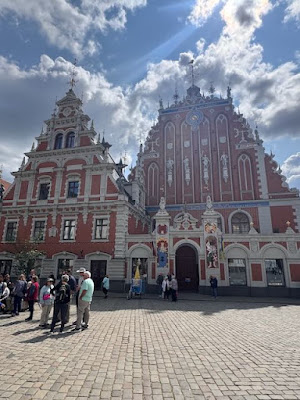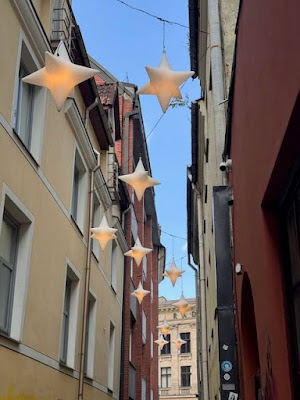Riga is the largest city and capital of Latvia. It has a population of almost 600,000 people. This chart from Wikipedia provides a clear explanation of the country's history of who ruled and when, dating back to the year 1201.
It is also important to note much of the city, especially the historic district, was destroyed during the Russian and German occupation in WWII beginning with the Russian occupation in June 1940 followed by Nazi Germany 1941-1944.
We walked from the pier where our cruise ship docked to The Old Town, the historic center of Riga.
Our first stop was St. James Cathedral.
The first church of St. James was built of wood in 1203 but burned in The Great Fire of Riga in 1215. The second church was built of stone, having additions and changes over the centuries. (This photo is from Wikipedia. The rest of the photos are mine.)
It is also known as St. Jacob's Church. Today, it is the Roman Catholic Cathedral of Riga.
Built of stone and dedicated in 1225. One source (not the website for the church) said it took nearly 70 years to build and wasn't completed until around 1300.
In 1522, during the Protestant Reformation, the building became the second German-language Lutheran church in Riga. In 1523, it became the first Latvian language Lutheran church there.
It is the smallest of the four Old Riga churches.
In 1582 it was given to the Jesuits as part of the Counter-Reformation when Stephen Báthory of the Polish–Lithuanian Commonwealth gained control of Riga. In 1621 it was returned to the Lutherans after Gustav II Adolf of Sweden occupied Riga. At various times it served as a Swedish language, German language, or Estonian language Lutheran church. After the Russian occupation of 1710, the church was named The Crown Church however, religious services in the German language were allowed to continue. In 1812 it was used as a storehouse for flour bags and other food supplies by Napoleon's troops. During that time, from June to November 1812, the congregation held services at St Peter's Church. ~ Wikipedia


In 1810, carpenter August Gothilf Heibel made a very beautiful pulpit in the Empire style for St. James's Church. The impressive, massive body of the mahogany structure is decorated with plant motifs and arabesque inlays. It has survived to this day and is one of the most important artistic monuments in St. James's Church. ~ Jekaba Katedrale
one of two side altars in the church
On July 25, 2019, the first shell sign in Latvia was unveiled and consecrated here as part of The Camino de Santiago, or St. James's Way, is a network of pilgrimage routes, all of which lead to St. Jacob's Cathedral in Santiago de Compostela, Spain, a distance of 4400 km. The shell, made by the sculptor Svetlana Saveljeva, a world-famous symbol of St. Jacob's Way, is embedded in the pavement at the entrance to the cathedral. ~ Information from the geocaching page. The shell was a geocache.
Near St. James Cathedral is The Three Brothers, a carefully preserved architectural dwelling complex dating back to the 15th century.
Legend has it that the houses were built by men from one family of craftsmen living in the suburbs of Riga. Now Maza Pils street, where the Three Brothers stand, is the very center of the old city.
⠀
The “Big Brother” or “White Brother” was the first to appear. Hosting a workshop, it was a place with one room where people worked, traded and lived. The exterior of the building combines the Dutch Renaissance and Gothic details.
⠀
The “Middle Brother” was built later, in the 17th century, in the style of Dutch mannerism. It embraced several dwelling spaces, including a spacious hall and living rooms.
⠀
The “Little Brother” or “Green Brother” joined the siblings in the 17th century. It has a curious facade motif: a mask designed to protect the house and the owners from evil powers. ~ The Three Brothers
Dome Square (Steeple from Riga Cathedral)
Dome Square is the largest square in the Old Town. It is deemed to be the heart of the city as all activities meet here, flowing in from seven streets like seven arteries. The square has seen many events significant to Latvia in the past 20 years. The square has a marked point where you can stand and see all three golden cockerels on top of Old Town's churches. The square itself is surrounded by buildings from the 19th and early 20th century. ~ Live Riga
Town Hall Square
There was supposed to be a cat on the top of the Riga sign, but a shop owner told us a dog was on the sign as maybe the cat was stolen?
Statue of Roland
Roland was depicted as a military man, who was a protector of the people. His statue, originally made of wood, was erected in towns during the Middle Ages, signifying the town privileges. The original statue is housed in St Peter’s Church. On the replica, if you look closely, you can see Roland also provides water, as there is a water fountain at his base. ~ ThatTravelLadyInHerShoes
Roland was nephew of Charlemagne and a Frankish military leader. The land he had occupied was governed stringently but justly; thus he gradually became the symbol of justice in Northern Germany. ~ Live Riga
Originally, the Statue of Roland was installed in 1896 at the site of the artesian well in the Town Hall Square. In 1999, when other buildings in Town Hall Square were updated, a replica of the original Roland statue was placed on a new pedestal at the well. In 2001, the water at the statue was connected to the city's water.
Town Hall was rebuilt in 2003 after its complete destruction in WWII. It is the exact copy of the original building of the 17th century, neo-classical design, including the coat-of-arms and statue of Themis, the Greek goddess of divine law and order. ~ ThatTravelLadyInHerShoes
House of Blackheads
This building is one of Riga’s most prominent and elaborately decorated with sculptures, coats of arms, a clock, and fancy weathervanes. In the 13th century a group of young, un-married, merchant men formed a society/club for entertaining. They held festivals, carnivals, and tournaments featuring the exotic foods and goods they brought back from their sea-faring adventures. They were very good at protecting their ships and caravans from looting pirates and robbers. These men were mostly German, but there were English, Scottish, Dutch, Swedish and Norwegian members also. The more the merrier and they all had something to contribute. Their parties were famous and included the aristocratic citizens of Riga, as well as the elite of Russia. ~ ThatTravelLadyInHerShoes

Their patron saint was St Maurice, supposedly a Black African Christian Roman commander, who died a martyr after refusing to kill Christians. A likeness of his head is on the Blackheads coat of arms, giving them their name. ~ ThatTravelLadyInHerShoes
There is a House of Blackheads in Hamburg that is still an operating organization.
In 1510, during their Christmas celebrations, that went from Christmas to New Years, these boys (from the Blackheads Guild) put a fir tree in the square, decorated it with paper roses (to represent the Virgin Mary) and then sang and danced around it. They ended up setting the tree on fire. So, it was claimed they had the first public display of a Christmas tree. ~ ThatTravelLadyInHerShoes
St. George slaying the dragon on the corner of the House of Blackheads
a squirrel moment
we had to sniff the lilacs
a rooster on a church steeple
Roosters on church steeples serve as a symbol of vigilance, repentance, and the triumph of Christ. This tradition stems from the biblical story of Saint Peter, who denied knowing Jesus three times before the rooster crowed. The rooster is a reminder of Peter's denial and subsequent repentance, as well as a symbol of the need for spiritual watchfulness. ~ AI Overview
I also read that the rooster on the steeple distinguished Protestant Churches from Catholic Churches. (???)
Three steeples, left to right: St. Peters, Riga Cathedral (Lutheran), Riga Castle
Riga Castle
(view of the castle from the river)
The castle was founded in 1330. Its structure was thoroughly rebuilt between 1497 and 1515. Upon the castle's seizure by the Swedes, they constructed spacious annexes in 1641. The fortress was continually augmented and reconstructed between the 17th and 19th centuries. Sometime in the 1930s, some renovation work was done. The Latvian government declared the castle its residence in 1938. Today it is the official residence of the President of Latvia as well as home to several museums. ~ Wikipedia
Next: Klaipeda, Lithuania, Stop #4













.jpeg)






.jpeg)





No comments:
Post a Comment
Thanks for your comments!